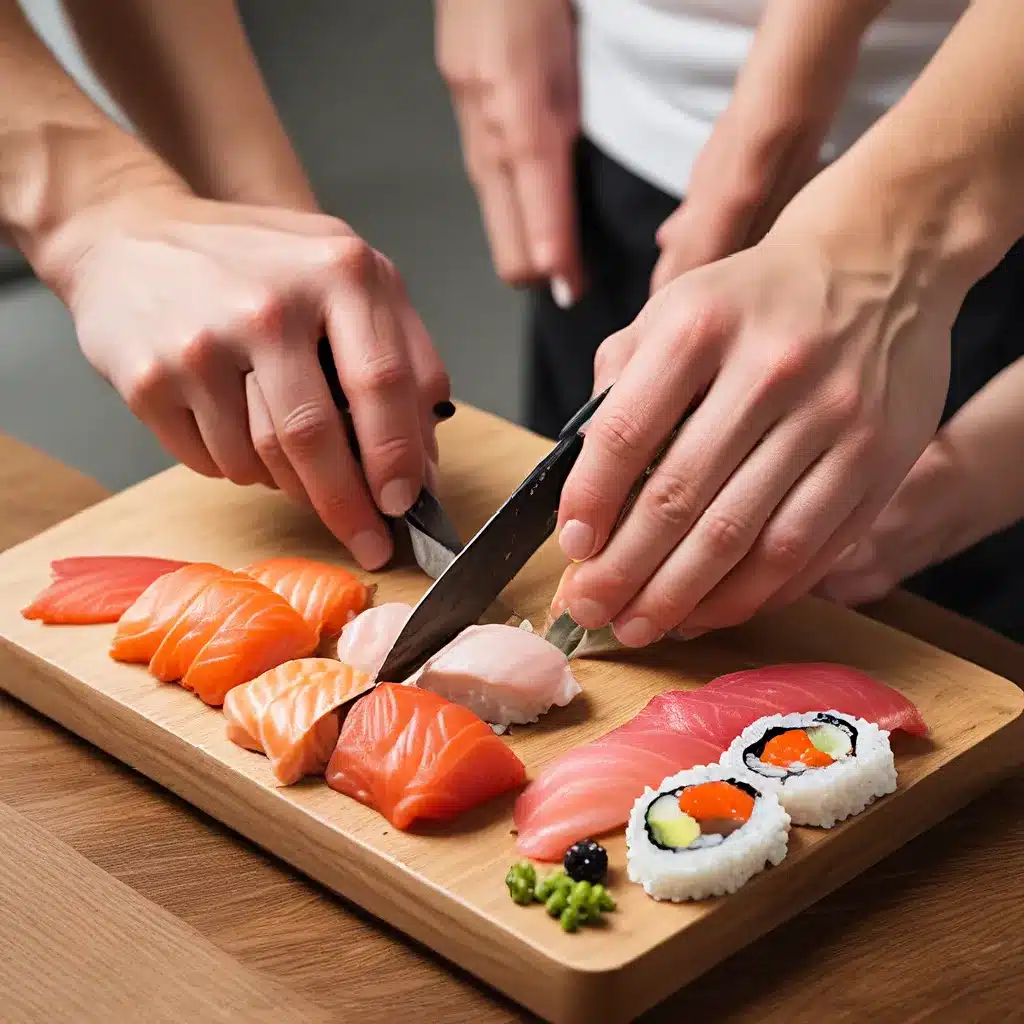
Mastering the Art of the Japanese Chef’s Knife
As an avid home cook, I’ve always been fascinated by the knife skills of Japanese chefs. The precision, speed, and grace with which they wield their blades to create intricate sushi dishes and vegetable garnishes is truly mesmerizing. It’s a level of culinary craftsmanship that takes years, even decades, to develop.
But what exactly makes these techniques so special? And how can we, as home cooks, incorporate some of that Japanese knife mastery into our own sushi preparation? Let’s dive in and explore the fascinating world of Japanese chef’s knife techniques.
The Uniqueness of Japanese Knives
The first key difference between Japanese and Western-style knives lies in their construction. Japanese blades are forged from a harder, yet thinner, steel – a combination that results in greater durability and the ability to be sharpened to an exceptionally fine edge. This razor-sharp precision is vital in Japanese cuisine, where delicate slices and paper-thin cuts are the norm.
Another distinction is the bevel, or the surface that’s ground to form the knife’s edge. While Western knives typically have a double-bevel, many Japanese knives feature a single-bevel design. This single-bevel construction allows for an even finer angle, enabling those clean, precise cuts that sushi chefs are renowned for.
Sharpening technique is also a key factor. Whetstone sharpening is the preferred method for Japanese knives, as it allows the user to maintain that razor-sharp edge. Using a sharpening rod or steel, which is more common for Western knives, is generally not recommended for Japanese blades, as the thin steel can be prone to chipping or cracking.
Essential Knife Techniques for Sushi Preparation
With an understanding of the unique qualities of Japanese knives, let’s explore some of the fundamental cutting techniques that sushi chefs employ.
Katsuramuki: The Vegetable Cutting Technique
Katsuramuki is one of the most well-known and admired Japanese chef knife techniques. It involves cutting long, wafer-thin sheets from cylindrical vegetables like daikon and cucumber. These delicate sheets can then be used to wrap around other ingredients, creating visually stunning sushi rolls. Mastering katsuramuki takes a great deal of practice, as it’s very easy to slip and cut oneself if not done with extreme care and precision.
Sengiri and Ken Cuts: Vegetable Precision Slicing
Sengiri and ken cuts are two other essential techniques used in sushi preparation. Sengiri involves creating thin strips of vegetables, which can be used to fill sushi rolls or as a garnish. Ken cuts, on the other hand, produce extremely thin, noodle-like pieces of daikon, often placed underneath sashimi as a contrast to the vibrancy of the raw fish.
Hira-zukuri and Usu-zukuri: Slicing Sashimi
When it comes to slicing sashimi, Japanese chefs employ two key techniques: hira-zukuri and usu-zukuri. Hira-zukuri involves cutting the fish into thin, rectangular slices, while usu-zukuri creates paper-thin, almost translucent slices. Both techniques require a razor-sharp knife and a steady, confident hand to avoid damaging the delicate fish flesh.
Knife Skills in Other Japanese Cuisine
While sushi and sashimi are the most well-known applications of Japanese knife techniques, these skills are also utilized in a variety of other traditional dishes.
Okonomiyaki: Versatile Cutting for Savory Pancakes
Okonomiyaki, the beloved Japanese savory pancake, doesn’t require the same level of precision cutting as sushi. As long as the ingredients are cut into somewhat uniform shapes to ensure even cooking, most slicing and chopping techniques can be employed.
Yakitori: Uniform Cubes for Even Grilling
When preparing yakitori – skewered, grilled bite-sized food items – the key knife technique is to produce uniform cuts of meat or vegetables. Generally, 1-inch cubes work best, as they’ll ensure the ingredients cook evenly on the grill.
Tonkatsu: Pounding for Even Frying
For tonkatsu, the Japanese version of a breaded pork cutlet, the crucial step doesn’t even involve a knife. Instead, the pork must be pounded with a meat mallet to an even thickness, ensuring it cooks evenly when deep-fried.
Teppanyaki: Dazzling Knife Artistry
Perhaps the most mesmerizing display of Japanese knife skills can be found in the world of teppanyaki – the theatrical style of tableside cooking on a flat-iron grill. In addition to mastering the techniques we’ve already discussed, teppanyaki chefs often learn a variety of knife-wielding tricks and flourishes to entertain and delight their diners. These dazzling displays take years of dedicated practice under the tutelage of expert teppanyaki masters.
Embracing the Journey
Becoming a true master of Japanese knife techniques is a lifelong pursuit, as evidenced by the fact that it can take a decade or more to become a fully-fledged itamae (sushi chef). But for those of us who are passionate about sushi, the journey is supremely worth it.
By understanding the unique qualities of Japanese knives and incorporating some of these fundamental cutting techniques into our own sushi preparation, we can elevate our home cooking and bring a touch of that Japanese culinary artistry into our kitchens. So, let’s pick up our knives, sharpen our skills, and embark on an exciting culinary adventure!
And don’t forget to check out the top-quality Japanese knives available at Herman Knives – the perfect tools to help you master the art of sushi preparation.


